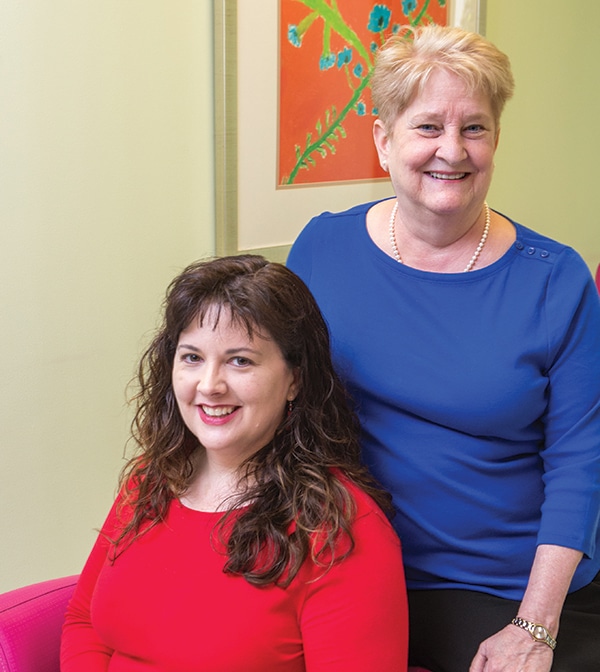Anne Paxton
May 2018—“One of these things is not like the others” is a fun puzzle for kids in the context of Sesame Street. But it can be a vexing informatics challenge when you are managing data entered in fields in a database. For anyone charged with merging outside laboratory results into an institution’s electronic health record alongside results from an in-house laboratory, the differences can generate no end of headaches.

Dr. Beverly Rogers (right) and Dr. Alexis Carter at Children’s Healthcare of Atlanta, where the laboratory formed an “enter/edit” team of three technologists who enter outside results into the EHR all day, with appropriate protocols and quality checks. “Combining different laboratories’ results into the EHR has the potential to present a patient safety risk every day,” Dr. Rogers says.
Photo credit: Jenni Girtman
Laboratories ordinarily wouldn’t volunteer to integrate results from outside sources into their laboratory information systems unless they were reference lab tests ordered by the lab. But sometimes institutional policy requires that other results go into the EHR. Outside results may have become part of the hospital’s workflow, or perhaps several hospital laboratories have been consolidated under a new health care system. Or clinicians or patients may be requesting it. As a result, there is often a need to integrate test results that the laboratory itself may have had little control over, pathology informatics experts say, and they agree that the task is anything but simple and straightforward.
“It’s a gnarly, complicated process,” says Beverly Rogers, MD, chief of pathology at Children’s Healthcare of Atlanta. She rates laboratory results reporting as one of the top concerns that arise with an EHR or EMR. In her view, “Combining different laboratories’ results into the EHR has the potential to present a patient safety risk every day.”
Classically, one of the initial hurdles to designing an electronic health record was the need to make a single record from an assortment of data types and formats—text, numeric values, tables, charts, photographs, scanned documents, 3D images, videos, and more. But merging lab results brings a new order of complexity. When coming from different laboratories, identical values in a test result field may not mean the same thing, different values may not signify actual differences, or the meaning of a value may have changed since it was entered.
“Outside laboratories can change their methods, reference ranges, and other test parameters on a moment’s notice without telling us,” Alexis B. Carter, MD, pathology informaticist at Children’s Healthcare of Atlanta, wrote last year in an Association for Pathology Informatics listserve discussion. “By the time we realize the danger of merging this new test method into our already existing results, an error may have already occurred. Confusion also occurs when providers don’t understand why two results that are the same number are flagged differently (normal versus abnormal).”

Dr. Krasowski
Matthew D. Krasowski, MD, PhD, vice chair of clinical pathology and laboratory services at the University of Iowa Hospitals and Clinics, in the same discussion compared the challenges to Whac-A-Mole. Among the safety issues his system has encountered in cases where lab values are hand entered and either do not have a reference range or use an inappropriate reference range:
- “Patients Google for information, searching for normal ranges themselves. In two cases, patients ended up on European sites that use different units of measurement and thought their values were markedly abnormal.”
- “For panels of testing, values often get flipped. We found that approximately five to 10 percent of CBC results hand entered, without ranges, flipped hemoglobin and hematocrit. Those were most obvious, given that this results in an implausible combination of values. I am guessing other parameters in the CBC have similar or higher rates.”
- “Unnecessary referrals generated from misinterpretation of lab values, often for labs that normally have gender- and/or age-specific ranges. Supposed ‘lymphocytosis’ was a common reason for referrals that turned out to be unnecessary once retesting at our main hospital used the correct reference range.”
Dr. Rogers has worked for several years with hospital and LIS analysts, clinical teams, and laboratory employees to establish systems that accurately merge external laboratory results into the EHR at Children’s Healthcare of Atlanta, which consists of three hospitals and a network of urgent care and neighborhood facilities. The state Medicaid agreements support Children’s as the lab of choice for outpatients seen at Children’s facilities, but managed-care contracts have not been negotiated to include outpatient laboratory testing, which is routed to LabCorp or Quest. The Children’s system wanted to set up a process whereby the outpatient tests sent to LabCorp or Quest would be ordered by the provider through the Children’s EHR, pass through a LabCorp or Quest interface, and then return in the form of results to the Children’s EHR.
While the electronic interfaces with LabCorp and Quest seem to be an easy solution to incorporating outside lab results into the Children’s EHR, it takes much effort from Children’s personnel to ensure that all results transfer as expected. “The system is set up to be a hands-off interface, but it really isn’t,” Dr. Rogers says. A study now in press found that thousands of interface errors crop up from LabCorp and Quest interfaces annually, and the Children’s staff need to fix each error manually, she says.
The errors come to light when the lab results hit the interface and don’t post to the EHR because they don’t match up correctly with the orders, Dr. Rogers explains. Some errors are demographic, with the referral laboratory entering a wrong birthday or a typo in a name. “But more significantly, the reference lab might have changed some part of the test, and so the results can’t be transferred through the interface to post electronically.” These variances disrupt the system of care, she says. “Because laboratory testing is often not seen as an important part of managed-care contract negotiations by health care systems, testing for outpatients may be routed to less expensive, high-volume commercial labs. However, the amount of time it takes for hospital employees to ensure the interface works well and all tests post correctly, in addition to troubleshooting complaints for care providers when results don’t post, may negate the savings.”
Many reference lab tests referred from the hospital lab, such as those that Mayo and ARUP perform, come through an interface into the Sunquest LIS, which transfers to the EHR. Even though interfaces with some reference labs exist, results from labs without interfaces as well as some of the more complicated tests need to be entered manually. “As a transplant center, Children’s often has patients who live significant distances from Atlanta. When they go home and have testing done in their local lab, it needs to be manually entered if it is to appear in the Children’s EHR,” Dr. Rogers says.
Several years ago, the laboratory had no control over the external lab results manually entered into the EHR, she says. “Clinic personnel would receive faxed lab results, show them to the doctors, and then send them to medical records to be scanned. Or someone would be hired by the clinic to enter the results into the EHR. So the results wouldn’t be in the medical record for sometimes two months. There were children who would come to the ED, and the results wouldn’t be there. Additionally, I would receive complaints from clinicians stating that the lab results didn’t make sense, only to realize after I looked into it that the result was entered by clinic personnel.”
Justifying the need for funding for laboratory personnel to enter results manually into the EHR was difficult, but eventually more issues were identified with decentralized entry, or no entry, of outside results, and so the hospital provided funding for a medical technologist to perform the manual entry. Through the years, the laboratory has formed an “enter/edit” team of three laboratory technologists who enter outside results into the medical record all day, with appropriate protocols and quality checks. “But it was a struggle to gain hospital approval. It’s hard for many outside the laboratory to see that manual entry of lab results is a remarkably error-prone activity.”
Visually, the results from outside appear on a separate line of a patient’s EHR and are marked “OSF” for manually entered results or with a LabCorp or Quest designation for electronically transferred results. “We’ll have Children’s in-house results—say, a potassium—and underneath it will be a LabCorp or Quest potassium on a separate line. It’s a complex display,” Dr. Rogers says, “but it’s as safe as we can make it, because the results aren’t all displayed as if they were from one lab.”
Each result’s reference ranges are displayed if a user hovers over the result. Still, it’s not always easy to ensure that doctors take the differences into account. “You can’t be casual when observing these results.” While a sodium tends to be a sodium no matter which lab performs it, she notes, other tests have more variation. Dr. Rogers knows of at least one event that stemmed from a C-reactive protein result that appeared to go down, but in fact the results were from different labs with different reference ranges and so the level had not declined. HbA1c results also can be prone to variation and require alertness on the part of clinicians.
Panels, or test groupings, can present major problems in ensuring that the electronic order and results point to the correct test. “Take a test such as a coagulation panel,” Dr. Rogers says. “Children’s might include six different tests within that panel. LabCorp may use 10 tests, five of which are different from Children’s. And Quest may use five tests, two of which are different.” So in mapping the Children’s tests or the tests clinicians order as a panel, “we have to be very careful to ensure accurate electronic transfer through the interface, which takes a lot of time and thought.”
It’s one reason among many that laboratory directors often choose to dodge the enterprise of merging results. “I called around to other large institutions, and the majority of lab directors said, ‘I don’t take responsibility for the quality or posting of outside lab results from labs required to be used by payers. It is not a lab I have chosen to send samples to, and I have no control over the relationship with the lab and no resources to get the results back into the EHR.’” In Dr. Rogers’ own case, where the hospital chose to merge the results through interfaces with commercial laboratories, she still finds it “completely unclear,” from a legal or regulatory perspective, precisely who is in charge of making sure that the outside results are merged correctly. Despite that, she feels a responsibility to provide oversight, and it was one reason she advocated for and hired an informaticist for her department. “People know me as the medical director of the laboratory,” Dr. Rogers says. When an error on lab resulting occurs, regardless of the source, “they’re going to contact me.”
“I believe the risk is not recognized by people outside the lab. Once errors begin to happen, the lab is not resourced appropriately or acknowledged to be the place that can fix it. It not only takes a lot of laboratory personnel’s time, but also the hospital’s information technology resources.”
On the question of merging lab results, arguments can be made for either side, says Michael D. Blechner, MD, MBA, medical director of clinical informatics at UConn John Dempsey Hospital in Farmington, Conn., which is facing some of the same pressures as Children’s Healthcare of Atlanta. “Our ambulatory patients mainly use our lab, but a significant number use Quest, and some people outside the laboratory have urged that lab results be merged now that we are in the throes of an Epic implementation, including a switch to Epic Beaker.”
“It has always been the lab’s stance that merging results is inappropriate due to differences in reference ranges, preanalytic handling, and so on,” Dr. Blechner, an assistant professor of pathology and laboratory medicine, wrote in the API listserv discussion. But “the fact is that there are some tests whose reference ranges would match very closely across labs, and arguably the benefits to clinicians of consuming/digesting merged data might outweigh the risks.” On the other hand, Dr. Blechner added, “Such an approach would require the selection and future monitoring of which tests would be appropriate for merging, a responsibility that we are inadequately staffed for.”

Dr. Jackups
Some institutions have realized the need for better policies when quality issues have surfaced from unstandardized additions of outside laboratory test results to the EHR. At Barnes-Jewish Hospital in St. Louis, where Ronald Jackups Jr., MD, PhD, is chief medical information officer for laboratory informatics, obstetrics and oncology lab results may sometimes be entered by nonlaboratory staff—medical assistants, for example—who transcribe from a hard copy the patient brings from an outside lab.
“Our hospital system has recognized the harm caused by unstandardized reporting of tests, even just naming conventions, and is building a steering committee made of lab administrative and IS leaders to work on the tests with the highest impact, starting with basic metabolic panel and CBC,” Dr. Jackups wrote on the API listserv. “What convinced them of the importance was when the hospital transitioned to an Epic EHR, and physicians complained they couldn’t pick the right name among the 12-plus options for the same test.”
If the system could be built from scratch, Dr. Jackups believes an established nomenclature, like LOINC, might be a solution. “But we’re not starting from scratch,” he wrote, “and such a wholesale change could have dramatic short-term consequences.” In addition, what’s good for an LIS may not be good for the computerized physician order entry system. “For instance, it may make more sense to call the PF4/hepatitis Ab test something like ‘HIT screen’ in your CPOE, since physicians may prefer to know the clinical function of the test rather than the actual name.”
On the other hand, when multiple hospitals’ information systems have to come together in an institutional merger, it can sometimes raise awareness of and attention to the comparability of laboratory tests. When Amanda G. Blouin, MD, PhD, was assistant director of validation for the laboratories at Mount Sinai Hospital in New York, multiple LISs fed directly into a single EHR. After Mount Sinai merged in 2013 with Beth Israel, St. Luke’s, and Roosevelt hospitals, she helped implement middleware between the LISs to fit the needs of the enterprise. Dr. Blouin, now an assistant director in the Department of Laboratory Medicine at Memorial Sloan Kettering Cancer Center, says the merger of labs and outreach produced opportunities not only to save money and shorten turnaround time but also to standardize testing.
Mount Sinai had an Epic EHR; the other hospitals had other EHRs. The merger led to a consolidation of testing performed at Mount Sinai, “but we weren’t integrating with their EHRs,” she tells cap today. “The interface was LIS to LIS. So from the clinician’s view, the display of results didn’t change, as if they originated from their own LIS to their EHRs.”
How did the management ensure comparability of results during the merger? Some tests were not moved over to Mount Sinai, Dr. Blouin says. “One reason we were successful was we did a deeper dive into exactly the differences among the tests.” By meeting with physician groups that were heavy users of a test, the management found some tests with a specific population and methodology that required much higher sensitivity than what Mount Sinai was offering. “So those tests weren’t moved over.”
During the building of an integrated health system, doctors may not be fully aware their lab results are coming from different labs, she says. “But now I think they’re more attuned to that. It’s one of the reasons clinicians try to follow trends” of results within a particular test method, rather than focus on individual test results. For tumor markers, for example, it is essential that the patient is tested by the same method over time, she says. “That’s something that clinicians who deal with tumor markers frequently would understand, but clinicians who don’t typically order that kind of test might not.”

Dr. Blouin
The dream that an EHR could offer patients a portable medical history is limited by the fact that lab results do not conform to the model of integration across an entire system, Dr. Blouin says. “For portability of lab results, we have to ensure portability of performance understanding—that physicians understand why these tests may not be equivalent. That can be through clinician education, but maybe at the laboratory level, too, we need to have a better understanding of performance correlations between different tests.”
As director of clinical pathology for Children’s Health medical centers in Dallas and Plano, Tex., Hung S. Luu, PharmD, MD, is the “informatics point person” for the department, he says. Dr. Luu has completed an integration of the system’s Epic EMR and Cerner LIS to handle testing performed by Quest and LabCorp. “A few years ago, I oversaw implementation of an interface with Quest and LabCorp where their information could flow into our EMR and post to the lab results section, without going through Cerner.”
Because the Quest and LabCorp results effectively bypass the laboratory IT management, “we consciously chose not to ‘own’ the results,” he says, meaning his laboratory doesn’t manage the interface. Not owning the results was important for his department, he says, because he has no oversight of Quest or LabCorp. “Anytime something is wrong—for example, a lab result is a critical value that is not communicated to the physician, or something got lost and a test could not be performed—our lab would be getting the calls from the physician when we didn’t draw the patient, we didn’t process the specimen, and we certainly didn’t perform it. That’s why we chose a deliberate separation between those results and the results we draw.”
It’s not only an issue of quality but also of staff resources. “We don’t get the revenue from those tests and that would be an invisible source of added work for us,” Dr. Luu says. If his laboratory were someday to be evaluated for efficiency and found to be doing fewer tests per medical technologist, “we wouldn’t be able to tell them, ‘Well, that’s because our resources are going toward having to manage all these LabCorp/Quest issues.’”
With reference testing, the situation is somewhat different, he explains. “Where I have leverage is that we have authority over whom to choose for a referral lab if we want to send it out to ARUP or Mayo or Quest.” But with the LabCorp/Quest tests, “the choice isn’t really ours. It’s the physician placing the order for the patient. We never see the patient or handle the specimen.”
Like Dr. Rogers’ institution, Children’s Medical Center Dallas has many transplant patients from out of town, and often its clinic staff enter those patients’ community hospital test results into its EMR manually. But to keep errors down, “we help them set up QC programs, where a certain percentage of the results have to be audited to make sure what we entered reflects the true results.”
To augment quality control with the LabCorp/Quest arrangement, “We would have somebody look at the test menus to decide which tests could go on the same line as our internal test result. We said, ok, CBCs and certain chemistry tests are pretty comparable, no matter the methodology and which lab performs them, so those can post to the same line on the record,” allowing results to be trended. Other tests, like albumin, often have different methods. “So we were not comfortable allowing those to post to the same line.” Different reference ranges for the same test present another problem, he says, and there is an ongoing effort to harmonize results across institutions.
Although it’s necessary to rely on some reference testing, “We try to limit the number of labs we have to deal with,” Dr. Luu says, “because if a patient comes in and gets a lab from ARUP and next week that goes to Mayo, are they useful to compare to each other? Or if you go today to a hospital and they tell you you have a low platelet count and the next day at a different ED they say you’re normal, that isn’t very useful to you. Where, really, is the truth?”
For comparison purposes, keeping tabs on the mean values at the hospital campuses’ on-site labs is part of the routine.
“Since QC is performed daily by the medical technologists, after a month all those QC points are accumulated for an internal report for pathology. And each month when I review those reports, we’re not only making sure all points are within an acceptable range, but also we’re looking at the average mean for each instrument on each campus and checking whether there may have been ‘drift’ in lab results at one campus versus the other campus.”
Because the on-site labs share common instrumentation, with the same administration and policies and procedures, “our labs are pretty closely aligned. If we buy an instrument, it will be at both labs.” He believes this practice has allowed the system to avoid some variation problems such as for tests like HbA1c, which may produce results that are one or two percent different, depending on the instrument. However, Dr. Luu notes, even in huge systems, patients aren’t necessarily going to visit multiple sites in the course of an illness. “They’re likely to have one site and return to that site for follow-ups. So it may not be as imperative that results at one campus match results at another.”
His institution uses the prefix “OSH” to indicate that a lab result is from outside the hospital. Is it enough for clinicians to appreciate the complexities of variations in the source of testing? “OSH is a pretty common convention, but I’m not sure that most clinicians understand the exact nuances of it,” he says.
“That is our biggest worry, and why we probably bend over backward to flag things and make sure to try to impress upon them that the results are from an outside facility and the internal lab probably doesn’t have any control over the quality. For the most part, clinicians, if they see a lab result posted in the EMR, typically just assume it has been vetted by the local lab and there’s no difference.” From a lab director’s standpoint, however, “there’s no worse feeling in the world than having to be responsible for something and then have no ability to implement what you think is important” to assure its quality, Dr. Luu says.

Dr. Levy
As complex as the informatics quandaries are now, even thornier issues lie ahead for laboratories worried about merging lab results. “We are rapidly moving into a time when patients will have increasing numbers of home-generated lab tests and other health data, such as vital signs or exercise data,” Bruce Levy, MD, associate chief medical informatics officer with Geisinger Health System, wrote on the API listserv. “We are studying how to best incorporate this type of data as well. I believe the solutions for these related issues should be consistent.”
While merging lab results is an area of advocacy for Dr. Luu, he knows that many laboratory directors prefer to sidestep choosing between two positions that may appear untenable and avoid the subject whenever possible. “I don’t really know what is the right answer. Is it that we keep everything separate and never draw anything that will be performed outside? Or do we bite the bullet and form a partnership, so we somehow have a hand in making sure all the results are accurate?” These are questions that laboratories and health systems must face, he says. “I don’t think we’re ever going to get to a solution without talking about it. Ignoring it, while it might be comfortable in the short term, is not a long-term solution.”
[hr]
Anne Paxton is a writer and attorney in Seattle.